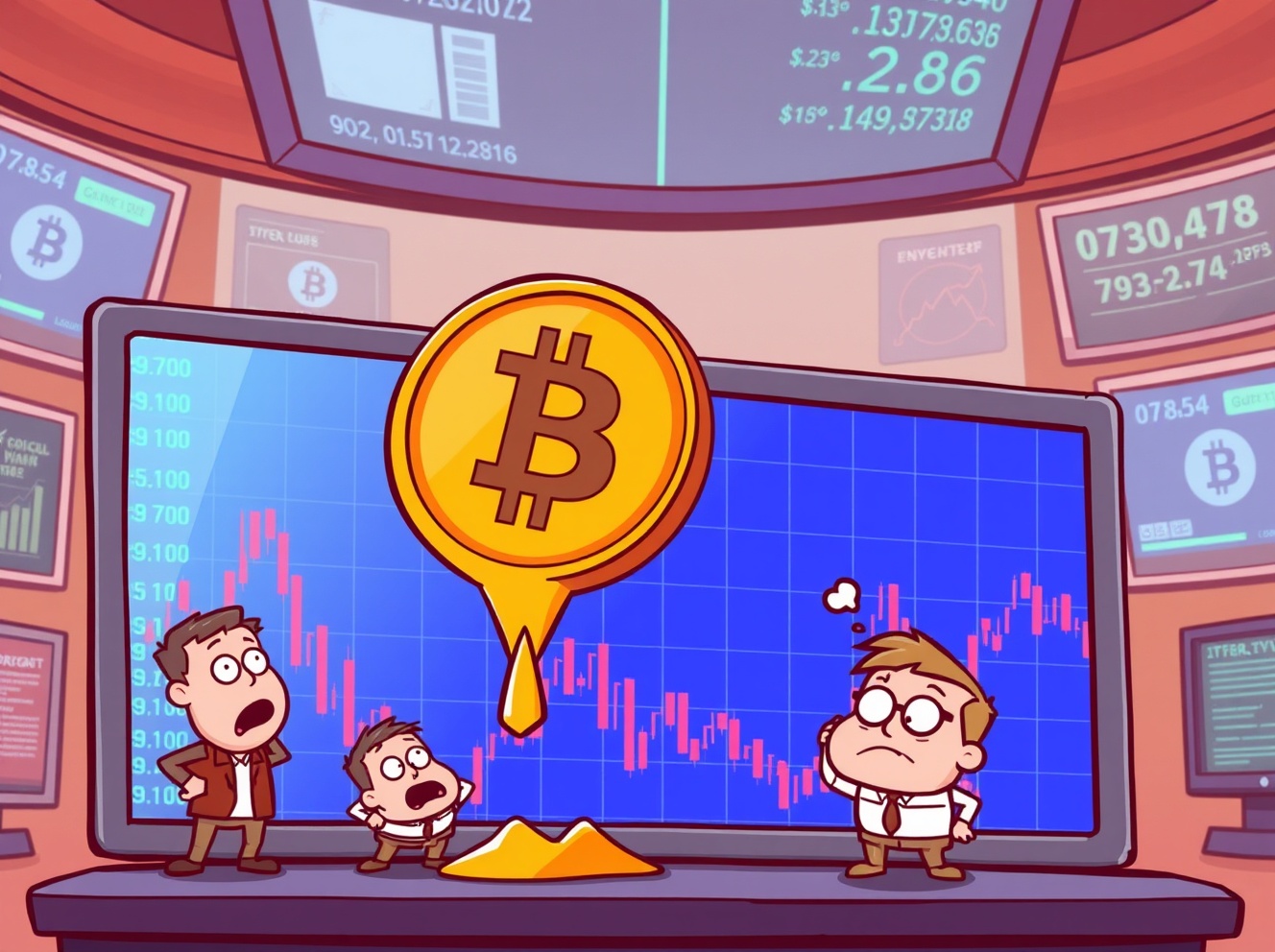
BitcoinWorld Shocking Bitcoin Price Drop: What $100,000 Means for Investors The cryptocurrency world is abuzz with recent developments as Bitcoin (BTC) has experienced a significant shift. What was once a psychological benchmark has now become a point of concern: a notable Bitcoin price drop has pushed the leading cryptocurrency below the $100,000 mark. According to real-time market monitoring by Bitcoin World, BTC is currently trading at $99,992.01 on the Binance USDT market. This movement has naturally sparked discussions among investors and enthusiasts alike, prompting many to question the underlying causes and potential future implications. What Triggered This Sudden Bitcoin Price Drop? When Bitcoin’s value shifts dramatically, especially crossing a major threshold like $100,000, it’s natural to seek explanations. While pinpointing a single cause for any Bitcoin price drop can be challenging, several factors often contribute to market movements. This particular dip could be influenced by a combination of macroeconomic trends, profit-taking by large holders (often called ‘whales’), or even broader market corrections. It is crucial to remember that the crypto market is inherently volatile. Price fluctuations are a common occurrence, driven by a complex interplay of supply and demand, investor sentiment, regulatory news, and global economic indicators. Therefore, understanding the broader context is essential when observing such movements. Understanding the Impact of BTC Falling Below $100,000 A Bitcoin price drop below a significant figure like $100,000 carries more than just numerical weight; it often impacts market psychology. For many, $100,000 represented a strong psychological support level, and its breach can trigger increased uncertainty or even panic selling among less experienced investors. However, seasoned traders often view such dips as potential buying opportunities or necessary market corrections. The immediate impact includes: Increased Volatility: Expect further price swings as the market digests this news. Investor Sentiment Shift: A move from bullish optimism to a more cautious, or even bearish, outlook in the short term. Liquidation Events: Traders using high leverage might face forced selling, adding downward pressure. It is important to differentiate between short-term market reactions and Bitcoin’s long-term trajectory. Historically, Bitcoin has shown resilience, recovering from numerous significant pullbacks. Navigating Volatility: What Should Investors Do Amidst a Bitcoin Price Drop? When faced with a significant Bitcoin price drop , making informed decisions is paramount. Panic selling often leads to losses, while a well-thought-out strategy can help mitigate risks and even capitalize on opportunities. Here are some general considerations for investors: Stay Informed: Keep up-to-date with reliable news sources and market analysis. Review Your Portfolio: Assess your risk tolerance and ensure your investments align with your financial goals. Consider Dollar-Cost Averaging (DCA): Instead of trying to time the market, consider investing a fixed amount regularly, regardless of price. This can average out your purchase price over time. Avoid Emotional Decisions: Market fluctuations can be stressful, but emotional reactions often lead to poor choices. Stick to your investment plan. Focus on Long-Term Potential: For many, Bitcoin remains a long-term asset. Short-term price movements, while dramatic, may not reflect its future value. The Road Ahead: What’s Next for Bitcoin’s Price? Predicting the exact future of Bitcoin’s price is impossible, but analysts often look for key indicators and support levels. The breach of $100,000 will likely lead to a re-evaluation of current support and resistance zones. Market participants will be closely watching for signs of stabilization or further downward momentum. Key factors influencing the next moves for Bitcoin’s price include global economic data, regulatory developments, and institutional adoption trends. While the recent Bitcoin price drop is notable, it’s part of the dynamic nature of cryptocurrency markets. Understanding these cycles and adopting a disciplined approach are crucial for navigating the evolving landscape. The crypto community will undoubtedly be watching closely to see how Bitcoin responds in the coming days and weeks. In conclusion, the recent Bitcoin price drop below $100,000 is a significant event that highlights the inherent volatility of the cryptocurrency market. While it has undoubtedly caused concern for some, it also serves as a reminder for investors to remain calm, informed, and strategic. Every market correction offers lessons and opportunities for those prepared to learn and adapt. The resilience of Bitcoin has been tested many times before, and its future trajectory will depend on a myriad of factors, both internal to the crypto ecosystem and external global influences. Staying vigilant and making well-researched decisions will be key for navigating these exciting yet unpredictable times. Frequently Asked Questions (FAQs) Q1: What does a Bitcoin price drop below $100,000 mean for the market? A1: It primarily signals increased market volatility and can affect investor sentiment, potentially leading to short-term uncertainty. For some, it may represent a psychological barrier being broken, while others see it as a buying opportunity. Q2: Is this Bitcoin price drop a sign of a bear market? A2: A single price drop, even a significant one, doesn’t definitively confirm a bear market. It’s a contributing factor, but a bear market is typically characterized by sustained price declines over a longer period and broader negative sentiment across the market. Q3: How quickly can Bitcoin recover from such a price drop? A3: Recovery times vary greatly depending on market conditions, investor confidence, and external factors. Bitcoin has historically shown strong recovery capabilities, but there’s no guaranteed timeline for a rebound. Q4: Should I sell my Bitcoin now that its price has fallen? A4: This article does not provide financial advice. Decisions to buy, sell, or hold Bitcoin should be based on your personal financial situation, risk tolerance, and thorough research. Panic selling is often discouraged by financial experts. Q5: What are the main factors that can influence a Bitcoin price drop? A5: Key factors include global macroeconomic trends (inflation, interest rates), regulatory news, major liquidations, profit-taking by large holders, technological developments, and overall investor sentiment. Q6: Where can I get reliable information about Bitcoin’s price movements? A6: Reputable sources include established financial news outlets, cryptocurrency analytics platforms, and official reports from market monitoring services like Bitcoin World. Always cross-reference information. If you found this analysis of the recent Bitcoin price drop insightful, consider sharing it with your network! Help others understand the current market dynamics and make informed decisions by spreading awareness on social media. To learn more about the latest crypto market trends, explore our article on key developments shaping Bitcoin price action . This post Shocking Bitcoin Price Drop: What $100,000 Means for Investors first appeared on BitcoinWorld .
Bitcoin World
You can visit the page to read the article.
Source: Bitcoin World
Disclaimer: The opinion expressed here is not investment advice – it is provided for informational purposes only. It does not necessarily reflect the opinion of BitMaden. Every investment and all trading involves risk, so you should always perform your own research prior to making decisions. We do not recommend investing money you cannot afford to lose.
Big Short Legend Michael Burry Bets Against AI Boom With Palantir and Nvidia Puts

Michael Burry’s Scion Asset Management is leaning hard against artificial intelligence (AI) highfliers, disclosing hefty put options on Palantir Technologies and Nvidia that together account for roughly 80% of a tightly focused, $44 million portfolio. Wall Street Déjà Vu: Trading Veteran Michael Burry’s Scion Bets Against AI Mania Scion’s latest 13F, released around Nov. 3, Bitcoin World

Expert to XRP Holders: BlackRock Just Confirmed What We’ve Been Saying
Recent comments from BlackRock CEO Larry Fink have reignited discussions within the cryptocurrency community about XRP’s potential role in global finance, particularly in the emerging tokenization market. Fink’s remarks, made during the Future Investment Initiative (FII) event in Riyadh, focused on how tokenization could transform the movement of money and assets worldwide, a development that many XRP supporters see as aligned with Ripple’s long-term vision. During his address, Fink stated that central banks around the world are now exploring how quickly they can digitize their currencies. He explained that this shift raises important questions about the future of the U.S. dollar, as well as the relevance of established payment companies such as Visa and Mastercard in a fully digital economy. Larry Fink Calls Tokenization the Next Major Financial Evolution Fink emphasized that while artificial intelligence dominates most conversations about financial innovation, the tokenization of assets and currencies represents an equally powerful trend. He described tokenization as a technological advancement that could streamline global finance by improving how transactions are processed and settled. According to him, many governments and institutions still underestimate the scale of this transformation. Larry Fink just confirmed what we’ve been saying for years, every central bank currency will be digitized, every ETF and asset will be tokenized, and they’ll all need a cross-border settlement layer. The plumbing of global finance is being rebuilt, and #XRP is the foundation. pic.twitter.com/hu0yArQeX7 — Black Swan Capitalist (@VersanAljarrah) October 29, 2025 His comments quickly gained attention within the XRP community, where advocates have long maintained that the XRP Ledger (XRPL) is well-positioned to support the tokenization era. Versan Aljarrah, founder of Black Swan Capitalist and a well-known XRP proponent, responded to Fink’s remarks by suggesting that they validate the long-standing view that XRP could underpin a new, tokenized financial infrastructure. Aljarrah asserted that in a future where central bank digital currencies (CBDCs), exchange-traded funds (ETFs), and other assets exist on tokenized platforms, a unified settlement network will be necessary. He argued that XRP’s design allows it to serve as the global bridge asset connecting diverse financial systems. Ripple’s Growing Focus on Tokenization Ripple’s own executives have echoed similar sentiments in recent years. In 2023, David Schwartz, Ripple’s Chief Technology Officer, confirmed that the XRPL’s development strategy would increasingly focus on tokenization capabilities. Bitwise, a major digital asset management firm, also named XRP as one of the tokens offering the most direct exposure to the anticipated growth of the tokenization sector. These developments have helped position XRP at the center of the broader discussion about how blockchain technology might power the future of financial markets. We are on X, follow us to connect with us :- @TimesTabloid1 — TimesTabloid (@TimesTabloid1) June 15, 2025 How High Could XRP Go If Tokenization Becomes Mainstream? To estimate what this global shift could mean for XRP’s valuation, a hypothetical scenario generated by Google’s Gemini AI offered an optimistic outlook. According to Gemini, the market for tokenized assets could expand to between $10 trillion and $26 trillion by 2030. Using a middle estimate of $15 trillion, Gemini projected that if the XRPL captured even 1–5% of that total market, XRP’s market capitalization could range from $6 trillion to $30 trillion. With roughly 60 billion XRP currently in circulation, this projection would place XRP’s price between $100 and $500 per token, assuming consistent adoption and supply conditions. However, Gemini emphasized that such an outcome would depend on several key factors, including regulatory clarity for digital assets, widespread institutional use of XRP for settlement, and Ripple’s ability to maintain a technological edge over competitors like Ethereum and Solana. It also noted that XRP’s deflationary token burn mechanism could gradually decrease supply over time, potentially reinforcing upward price momentum if demand increases. Although these estimates remain speculative, the renewed discussion following Larry Fink’s comments underscores a growing belief that tokenization could reshape global finance and that XRP might play a meaningful role in that transformation. Disclaimer : This content is meant to inform and should not be considered financial advice. The views expressed in this article may include the author’s personal opinions and do not represent Times Tabloid’s opinion. Readers are urged to do in-depth research before making any investment decisions. Any action taken by the reader is strictly at their own risk. Times Tabloid is not responsible for any financial losses. Follow us on Twitter , Facebook , Telegram , and Google News The post Expert to XRP Holders: BlackRock Just Confirmed What We’ve Been Saying appeared first on Times Tabloid . Bitcoin World











